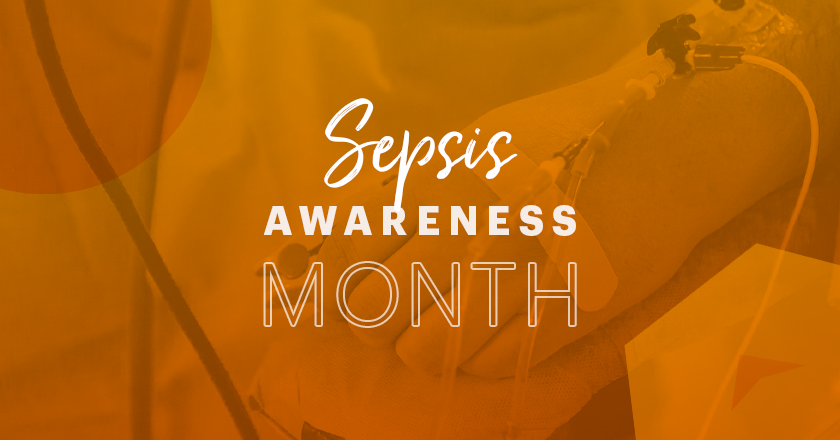
One condition that’s constantly on the minds of our front-line healthcare staff is sepsis – a reaction to infection during which the body’s immune system goes “AWOL” and starts to attack its own tissues and organs. If left untreated, sepsis can result in organ failure and death.1
According to the UK Sepsis Trust, a quarter of a million people every year in the UK are affected by sepsis: 52,000 people die each year because of sepsis, and 60,000 suffer permanent damage2. In light of World Sepsis Awareness Month, we at Onyx Health are going to share with you the need-to-know about sepsis to help you to better understand the condition.
Sepsis is an indiscriminate condition that affects the lives of the young and the old, regardless of their physical health status. It is not a clear-cut condition like asthma or diabetes but a vague term indicative of infection, blood poisoning, and septicaemia.3
Simply put, sepsis is your body’s toxic reaction to infection, instead of fighting off the infection, your immune system attacks your body instead. Your blood pressure can drop extremely quickly, your organs could fail, and you may need ventilator-assisted breathing.4 In short – sepsis can kill you.
The 2017 Global Burden of Sepsis study produced data according to age, sex, location, and cause of sepsis. The study found that in 2017, sepsis affected 48.9 million people and resulted in 11 million deaths worldwide.5 However, the nature of the disease coupled with the COVID-19 pandemic is expected to significantly raise these figures, highlighting further the necessity of early identification.6
The word ‘sepsis’ comes from the Greek words for ‘decomposition’ and ‘decay’.7 In the UK, sepsis is more common than heart attacks and has a mortality rate higher than that of bowel cancer, breast cancer, and road accidents combined, costing the economy over £15 billion each year.2
Understanding sepsis and its associated warning signs can be lifesaving, allowing you to seek to appropriate help promptly. There are many possible symptoms of sepsis, most of which resemble that of a chest infection or nasty flu. Thus, spotting sepsis may be tough. NHS England has set out a list of ‘red flag’ symptoms to watch out for that may indicate sepsis8, including:
Despite the harrowing statistics and the condition’s catastrophic impact on patients, awareness of sepsis is astoundingly low. Around 75% of the British public have heard of sepsis, but of those who are aware, 25% do not realise it could be a medical emergency.9
One key factor may be attributed to the fact that sepsis, unlike asthma or HIV, does not affect individuals on a day-to-day basis.3 Of those who survive the sepsis struggle, most would be unwilling to look back and discuss their experience due to ICU-related post-traumatic stress10 and depression11, making it difficult for them to speak out about their experiences.
Sepsis is a silent killer that can often be confused for the likes of a chest infection or a bad cold. In some instances, people may believe the symptoms of sepsis are just the body’s natural response to infection. Unfortunately, this isn’t right. More education surrounding the topic must be introduced to both the general public and healthcare professionals to raise awareness about this hidden health threat.12
World Sepsis Awareness Month is an initiative aimed to provide healthcare professionals and the general public alike with better education about the condition. The focus is to enhance the quality of care for patients, raise awareness of the symptoms of sepsis, and crucially, allow those displaying signs of sepsis to seek immediate treatment.
If sepsis is identified early, it’s treatable – mostly. Word needs to get out to communities across the UK about how to recognise signs of sepsis, and emphasis must be put on the necessity of getting immediate help. So, the question is, what can you do to raise awareness of sepsis?
Awareness begins the moment your close circle of family and friends are educated and alerted to the potential risk. Although sepsis isn’t the first topic of choice around a family BBQ or Friday Pub Night, ensuring it pops up in conversation may save lives. Talk to your friends and family about sepsis. You can impress them using big words like septicaemia while emphasising the NHS red flags to look out for.
You can spread the message of sepsis awareness to acquaintances you’re connected with on all forms of social media. By sharing Sepsis Awareness Month posts on social media, you’re actively encouraging your followers, friends, and family to engage in discussions surrounding the topic.
If, after reading this, you’ve decided to take your sepsis education one step further, then why not take a look at the many webinars available online? Most are free, presented by healthcare professionals or sepsis charities, and provide invaluable information that can help you better understand the condition and its treatment.
World Sepsis Awareness Month aims to educate the general public about the benefits of early detection and treatment of sepsis, saving around 14,000 lives each year in the UK and resulting in 400,000 fewer days a year in hospital for affected patients. This could save the UK economy as much as £2.8 billion a year.2
We can’t vaccinate for sepsis. We can’t eradicate sepsis. All we can do is educate people about sepsis, with the hopes to spread the word about the necessity of early detection. Why not play your part this year’s World Sepsis Awareness Month by talking to your friends and family? The future of someone you love may depend on it.